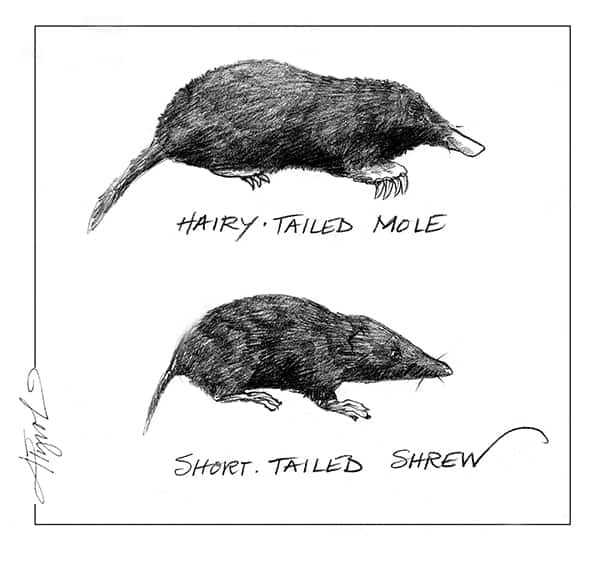By Tiffany Soukup
In November, I was making soup to stock the freezer when I looked out my kitchen window and spotted a red squirrel rustling through the leaves in search of acorns. Both of us were preparing for harder days ahead — me for an upcoming hip replacement surgery, the squirrel for the approaching snowy season. What other animals, I wondered, were preparing for winter — and how?
Some animals, of course, spend the cold, dark months of winter hibernating. Others, like the squirrel searching for acorns, stock their winter larders and hope they have food to last until springtime. Among the latter group are shrews and moles. Their diet comprises insects and other invertebrates, and they have mastered the art of keeping a fresh meal on hand at any time of the year. Both moles and shrews maintain special underground chambers for storing live prisoners beneath the snow.
“Shrews are one of the most predacious small mammals, eating constantly,” said Dan Feller, an ecologist with Maryland’s Dept. of Natural Resources. “They basically attack anything that moves.”
Shrews are also the only venomous mammal in North America. Northern short-tailed shrews (Blaina brevicauda) have 32 teeth for chewing on invertebrates, plants, and small mammals. Unlike venomous snakes, whose hollow fangs contain the venom, these shrews instead have a submaxillary gland that produces venom, and grooves in their lower incisors that transmit that venom into prey, which becomes paralyzed within minutes of being bitten by a shrew.
Shrews may move their alive-but-immobile prey back to a special live hoarding chamber. One study found that shrews cached approximately 87% of their captured prey. Making their own shallow runways under surface litter, they often utilize tunnels of mice and moles — and they use echolocation to navigate and locate prey. Shrews have the highest metabolic rate of any mammal in North America, a heartrate of approximately 700 beats per minute, and have been recorded to have 12 body movements per second.
If a shrew does not eat within a few hours, it will likely die.
Shrews diligently store snails, beetles, mealworms, and other prey. Studies of shrew caches reveal that a mealworm can remain alive and paralyzed for up to 15 days.

The hairy-tailed mole (Parascalops breweri) is another winter cache-er and tunnel digger extraordinaire. These moles use a combination of temporary surface tunnels and deeper permanent tunnels, some 15 inches below the surface, for transportation, sleeping, and (of course) special chambers for holding live prey. Strong, spade-shaped front feet push soil under their body while back legs kick it backwards. Soil from surface tunnels tends to be pushed upwards, creating tell-tale molehills. Velvety fur offers no resistance to dirt, which allows these moles to move forward or backward with ease.
In summer, hairy-tailed moles can dig a 160-foot tunnel in just one night. For comparison, that would be like a human digging a tunnel half a mile long. This digging — and the creation of molehills — means moles are often considered pests. But all that digging helps to aerate the soil, and moles eliminate unwelcome insects. In winter moles remain active in permanent tunnels below the frost line. Successive generations may use the same tunnels for eight or more years.
Moles locate their prey using their strong sense of touch and smell and have a varied diet of insect larvae and pupae, slugs, snails, and centipedes, although earthworms are a favorite food. Like short-tailed shrews, moles have toxins in their saliva. A bite to an earthworm’s head immobilizes the victim, which moles then store in a feeding chamber within their network of tunnels.
In “Earthworm Ecology,” edited by renowned entomologist Clive Edwards, researcher James P. Curry noted, “Large quantities of mutilated earthworms are stored in caches within a mole fortress as future food.”
One study found 470 live earthworms in a single chamber. This amounted to nearly two pounds of worms. A study of moles in Britain found a single mole consumes approximately 39 to 70 pounds of earthworms annually.
As we endure whipping winds, freezing sleet, and icy winter conditions, beneath our feet there are tunnel systems full of life — including caches of immobilized prey. When I next catch a glimpse of a shrew or mole, I will wonder how many prisoners this little creature has in its underground hoard.
Tiffany Soukup is a writer, photographer, park manager with Vermont State Parks, and traveler. Illustration by Adelaide Murphy Tyrol. The Outside Story is assigned and edited by Northern Woodlands magazine and sponsored by the Wellborn Ecology Fund of the New Hampshire Charitable Foundation: nhcf.org.



